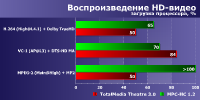- VEGA in Citylink is MUCH cheaper than anywhere else
- Mid-range hit Lenovo K5 Note 30% cheaper at Citylink
- !!! GTX 1070 Gigabyte Stack 3x for an even MORE SUPER price
You can mark sections of text that interest you,
which will be available through a unique link in the address bar of the browser.
Testing processors LGA 1155, socket FM1, socket FM2 in 2D
Dmitry Vladimirovich 03/09/2013 00:00 Page: 1 of 5| | print version | | archive
- Page 1:
- Page 2: Test configurations, power consumption, test results: Jellyfish 35/60/120 Mbps video playback
- Page 3: Test results: WinRAR 4.2, Java Micro Benchmark, Excel BenchMark, XnView
- Page 4: Test results: Xilisoft Video Converter Ultimate, Xilisoft Audio Converter Pro, Pinnacle Studio 16, Adobe Photoshop CS6 (x64)
- Page 5: Test results: Cinebench (x64), final results: performance-price ratio and power consumption, performance-price ratio, summary table, conclusion
Twenty-one processors, three platforms, thirty-six modes - what is this, the construction of the century? Not even at all. This is just the start of testing. Intel models and AMD in various software environments, made possible with the help of our trusted partner, Regard . The emphasis is on everyday use. SPEC, Maya, SolidWorks, Lightwave, VRay, Autodesk - you will not see any of the above in the review. But you are waiting for results in quite ordinary programs, those that we, I, they use daily, weekly, at work and at home. And with what we are constantly doing for a number of reasons beyond our control.
You shoot home video, no, you thought wrong about Home Video, everything is simple to the point of banality, this is the video that we shoot in nature, riding a board or skiing, cycling or rollerblading. We take pictures with a camera and then process the photos with the tools familiar to us in programs. We work in the Office package, calculate in Excel. Download files from the Internet and unpack them. All those things that many of us do on our home and work computers.
And since we are talking about entertainment, we need to see how quickly we transcode films into a “tablet format” or prepare audio files excellent quality FLAC to the popular MP3 format. I will not now focus your attention on the comparison between Intel solutions and AMD, but I will conduct a test without being tied to a specific manufacturer. Last but not least, this is due to the price of processors.
The fact is that I did not find a sufficient assortment of CPUs for an honest comparison. Instances of Intel products are several times more expensive than AMD models, but this does not mean that they will not take part in the comparison in the future, on the contrary, I really look forward to them. For now, back to brief description processors.
Technical characteristics of processors with integrated graphics core
Intel Model Specifications (LGA 1155, Ivy Bridge).
| Model | Clock frequency | Intel® Turbo Boost | If- number of cores | If- number of streams | Cache | Graphic model cal system | Graphics frequencies cal core | Recommended bathroom price, $ | ||
| Celeron G1610 | 2.6 GHz | - | 2 | 2 | 2 MB | Intel® HD Graphics | 650-1050 MHz | 55 watts | 42 | 1500 |
| Celeron G1620 | 2.7 GHz | - | 2 | 2 | 2 MB | Intel® HD Graphics | 650-1050 MHz | 55 watts | 52 | 1900 |
| Pentium G2010 | 2.8 GHz | - | 2 | 2 | 3 MB | Intel® HD Graphics | 650-1050 MHz | 55 watts | 64 | 2100 |
| Pentium G2020 | 2.9 GHz | - | 2 | 2 | 3 MB | Intel® HD Graphics | 650-1050 MHz | 55 watts | 64 | 2100 |
| Pentium G2120 | 3.1 GHz | - | 2 | 2 | 3 MB | Intel® HD Graphics | 650-1050 MHz | 55 watts | 75-82 | 2600 |
| Pentium G2130 | 3.2 GHz | - | 2 | 2 | 3 MB | Intel® HD Graphics | 650-1050 MHz | 55 watts | 86-93 | 2900 |
| Core i3-3210 | 3.2 GHz | - | 2 | 4 | 3 MB | Intel® HD Graphics 2500 | 650-1050 MHz | 55 watts | 117-120 | 3700 |
| Core i3-3220 | 3.3 GHz | - | 2 | 4 | 3 MB | Intel® HD Graphics 2500 | 650-1050 MHz | 55 watts | 117-125 | 3800 |
| Core i3-3225 | 3.3 GHz | - | 2 | 4 | 3 MB | Intel® HD Graphics 4000 | 650-1050 MHz | 55 watts | 134 | 4400 |
| Core i3-3240 | 3.4GHz | - | 2 | 4 | 3 MB | Intel® HD Graphics 2500 | 650-1050 MHz | 55 watts | 138-147 | 4500 |
| Core i5-3330 | 3.0 GHz | 3.2 GHz | 4 | 4 | 6 MB | Intel® HD Graphics 2500 | 650-1050 MHz | 77 watts | 182-187 | 5600 |
| Core i5-3450 | 3.1 GHz | 3.5 GHz | 4 | 4 | 6 MB | Intel® HD Graphics 2500 | 650-1100 MHz | 77 watts | 184-195 | 5800 |
| Core i5-3470 | 3.2 GHz | 3.6 GHz | 4 | 4 | 6 MB | Intel® HD Graphics 2500 | 650-1100 MHz | 77 watts | 184-195 | 5800 |
| Core i5-3550 | 3.3 GHz | 3.7 GHz | 4 | 4 | 6 MB | Intel® HD Graphics 2500 | 650-1150 MHz | 77 watts | 205-213 | 6400 |
| Core i5-3570 | 3.4GHz | 3.8GHz | 4 | 4 | 6 MB | Intel® HD Graphics 2500 | 650-1150 MHz | 77 watts | 205-213 | 6400 |
| Core i5-3570K | 3.4GHz | 3.8GHz | 4 | 4 | 6 MB | Intel® HD Graphics 4000 | 650-1150 MHz | 77 watts | 225-235 | 7600 |
| Core i7-3770 | 3.4GHz | 3.9 GHz | 4 | 8 | 8 MB | Intel® HD Graphics 4000 | 650-1150 MHz | 77 watts | 294-305 | 9100 |
| Core i7-3770K | 3.5 GHz | 3.9 GHz | 4 | 8 | 8 MB | Intel® HD Graphics 4000 | 650-1150 MHz | 77 watts | 332-342 | 10300 |
Specifications of AMD models (socket FM1, Llano).
| Model | Clock frequency | Turbo Core | If- number of cores | If- number of streams | Cache | Graphic model cal system | Graphics frequencies cal core | Maximum rated power | Recommended bathroom price, $ | Average retail price, rubles |
| A4-3300 | 2.5 GHz | - | 2 | 2 | 1 MB | HD6410D | 443 MHz | 65 watts | 35-40 | 1200 |
| A4-3400 | 2.7 GHz | - | 2 | 2 | 1 MB | HD6410D | 600 MHz | 65 watts | 40-50 | 1200 |
| A6-3500 | 2.1 GHz | 2.4GHz | 3 | 3 | 3 MB | HD 6530D | 443 MHz | 65 watts | 60-70 | 1900 |
| A6-3600 | 2.1 GHz | 2.4GHz | 4 | 4 | 4 MB | HD 6530D | 443 MHz | 65 watts | 80-90 | 2400 |
| A6-3620 | 2.2 GHz | 2.5 GHz | 4 | 4 | 4 MB | HD 6530D | 443 MHz | 65 watts | 80-90 | 2400 |
| A6-3650 | 2.6 GHz | - | 4 | 4 | 4 MB | HD 6530D | 443 MHz | 100 watts | 70-80 | 2400 |
| A6-3670K | 2.7 GHz | - | 4 | 4 | 4 MB | HD 6530D | 443 MHz | 100 watts | 80-90 | 2400 |
| A8-3800 | 2.4GHz | 2.7 GHz | 4 | 4 | 4 MB | HD 6550D | 600 MHz | 65 watts | 90-100 | 3000 |
| А8-3820 | 2.5 GHz | 2.8 GHz | 4 | 4 | 4 MB | HD 6550D | 600 MHz | 65 watts | 90-100 | 3000 |
| А8-3850 | 2.9 GHz | - | 4 | 4 | 4 MB | HD 6550D | 600 MHz | 100 watts | 85-95 | 2800 |
| A8-3870K | 3.0 GHz | - | 4 | 4 | 4 MB | HD 6550D | 600 MHz | 100 watts | 80-90 | 2800 |
Specifications of AMD models (socket FM2, Trinity).
| Model | Clock frequency | Turbo Core | If- number of cores | If- number of streams | Cache | Graphic model cal system | Graphics frequencies cal core | Maximum rated power | Recommended bathroom price, $ | Average retail price, rubles |
| A4-5300 | 3.4GHz | 3.6 GHz | 2 | 2 | 1 MB | HD 7480D | 723 MHz | 65 watts | 50-60 | 1600 |
| A6-5400K | 3.6 GHz | 3.8GHz | 2 | 2 | 1 MB | HD 7540D | 760 MHz | 65 watts | 65-75 | 2200 |
| A8-5500 | 3.2 GHz | 3.7 GHz | 4 | 4 | 4 MB | HD 7560D | 760 MHz | 65 watts | 105-115 | 3400 |
| A8-5600K | 3.6 GHz | 3.9 GHz | 4 | 4 | 4 MB | HD 7560D | 760 MHz | 100 watts | 100-110 | 3200 |
| A10-5700 | 3.4GHz | 4.0 GHz | 4 | 4 | 4 MB | HD 7660D | 760 MHz | 65 watts | 130-140 | 3700 |
| A10-5800K | 3.8GHz | 4.2 GHz | 4 | 4 | 4 MB | HD 7660D | 800 MHz | 100 watts | 120-130 | 4200 |
Platforms FM1 and FM2 got to the testing in full force for a reason. Interest in APUs is constantly growing, and AMD's developments in this area will soon be in a multi-platform set-top box. And it is all the more interesting to check how much the gap between FM1 and FM2 has grown, and maybe completely disappeared. Will join them Intel processors. True, on this moment only a small proportion of them take part in testing, but with what we have on hand, we can draw certain conclusions.
Testing tools and methodology
The level of energy consumption is measured in three dimensions.
- The first, during idle time: all power-saving features of the motherboard (not the processor) are disabled.
- Second: 100% CPU load is carried out by running Prime x64.
- Third: 100% CPU + GPU utilization - in addition to Prime x64, EVGA OC Scanner X appears.
It is worth talking a little about the programs used in testing and the reasons for choosing them.
Playing a video file using the classic player Media Player Classic with default KLite codecs installed. The source video is taken from Jelly Fish with different speed streams from 35 Mbps to 120 Mbps. The first is typical for HD movies, those that we are used to buying and downloading from the Internet. 60 Mbps is equivalent to Blu-ray, while 120 Mbps is the equivalent of the emerging 4K standard. The load of the cores (average and maximum), as well as the number of dropped frames, is estimated. On modern processors there is practically no frame jerking effect, and the number of frames in 99 cases out of 100 is easily kept at around 24.9-25.
WinRAR 4.2 x64- Built-in performance test is used. The program itself is located on the disk partition, which is located on SSD drive, thus excluding poor performance classic HDD. The test result is the average value obtained after three runs of the program. WinRAR appears in this review for a reason, because we often have to download and unpack files. Moreover, RAR is very common among archivers and supports multithreading well.
Java Micro Benchmark. An atypical test among processor reviews. Java Micro Benchmark allows you to compare system performance across platforms.
Excel BenchMark an even rarer visitor. Initially, the task was to check the speed of work in the Office package. Converting from Word to PDF works well, but there is too much dependence on the rest of the system configuration, especially the HDD. And performance growth is often higher from changing the frequency random access memory than from an additional 100-200 MHz processor frequency. Therefore, I had to look for a more adequate test that loads the processor-memory-chipset bundle. Fortunately, such a test was found, and I saw an additional attraction after the update. test file. The author of the benchmark is definitely not sitting idly by. So what is an Excel test? Initially, this is a table with data, according to which a dynamically changing graph is built during the benchmark execution.
There are six subtests in total.
- The first one creates five columns * 65,535 rows of random data.
- The second one displays the time required to calculate the indicator for five columns of 65,535 rows of data created in the first test.
- The third - shows the speed of displaying price changes in 30 seconds.
- Fourth, 63,000 price-changed values are converted into OHLC data.
- The fifth is a test using several conditions (wait until all the values of price changes are formed) and calculation formulas. As a result, you can see the result of the number of price changes that can be completed with the recalculation formula within 30 seconds.
- Sixth - This test is identical to the fifth, except that all formulas simultaneously depend on the change in the cell, E5000.
XnView A fairly common program for viewing photographic material. It's free and easy to use. Additionally, it has built-in simple functions for converting formats, making changes, and others. I was interested in a casual look at the test, more precisely, for how long the program will make changes and save 35 NEF files. Typical requirements for an amateur photographer. But the task is complicated not just by changing the format in JPG, but also by the requirement to make changes in graphic files. The most simple and obvious things were chosen: changing the color balance, changing the temperature, leveling the horizon, removing the bulge, adding sharpness, resizing up to 1900 pixels on the largest side. I will not say that all resources are involved in the testing process, but the result depends on the speed of the processor by 85%. The remaining 15% is affected by the hard drive.
Xilisoft Video Converter Ultimate is a popular video converter. I used it for one reason - it can load the processor well, using its capabilities by 100%. From the whole list of possibilities, my choice fell on a 20-minute video file with one episode of the series in MKV 720p format, and the output should be a convenient file for viewing on a tablet. A task common among tablet owners who are buying more and more users. Of course, over the years, the number of CPU cores and GPU power in them has been growing, but still not all instances can play unconverted video.
Xilisoft Audio Converter Pro. We convert an artist's album from FLAC to MP3, suitable for use in phones, tablets and players. The FLAC file is monotonous and filled with all the songs in sequence, we need to break it into songs and save each one to MP3. A simple action for the user, but not a simple one for the system. The problem is that most audio converters do not load all cores, meaning they are single-threaded jobs. Alas, I could not find suitable program, which adequately loads the processor, but it will be interesting to check how single-core acceleration technologies work on processors from different companies.
Pinnacle Studio 16 – a new version the most famous video processing platform. This is Pinnacle Studio's first release since Corel acquired Avid's consumer video editing business. Theoretically, during the final assembly of video material, the program uses all processor technologies, but most importantly, it is multi-threaded! The program itself is very common among amateur editing systems, and we don’t need much. I decided to combine several fragments from the action camera into one, supply them with smooth transitions and bring the picture to the same temperature, as well as color balance and sharpness.
Adobe Photoshop CS6 (64 Bit)- many words are useless here. The last available Adobe product. The result of testing is the time of applying filters to one picture. I did not become like many and took an ordinary JPG file of medium size. And then I went through the filters, resizing, gamma settings and more. Quite a typical set for the program. Unlike video encoding, Photoshop never became multi-threaded; rather, it can be called a moderately CPU-intensive program.
Cinebench x64 is a common CPU test in render. Initially, I would like to provide the results in Autodesk 2013 packages, but due to the tight tie to the system configuration, when changing the processor, new registration product. And even after re-registration, the package does not work properly, as a result, I had to abandon it. Having the results of one system with different processors in Autodesk, I compared them to the difference in Cinebench testing and found no significant difference.
The results are presented both in the form of a table and in the form of a summary graphical table. In order to compare processors, it is enough to select the model you are interested in horizontally, and the compared CPU vertically, in the cell you will see the percentage difference in performance between the first and second CPUs.
- Page 1: Introduction, technical characteristics of processors with an integrated graphics core, tools and testing methodology
- HTC U Play in Citylink is cheaper than gray sellers
- !!! Drain GTX 1070 Gigabyte Rock, super price!
- 4k flagship Sony XZ Premium - see the price!
- Processors i3-2100, Penium G850 and Pentium G620;
- maternal ASUS board P8P67 Deluxe;
- Processor Pentium G6960;
- Motherboard ASUS P7P55D PRO;
- Memory 4 GB DDR3-1067 7-7-7-21 (Kingston KHX1600C8D3K2/4GX).
- Athlon II X2265 and Athlon II X3 455 processors;
- Motherboard M4A89TD PRO;
- Memory 4 GB DDR3-1600 9-9-9-27 (Kingston KHX1600C8D3K2/4GX).
- CPU-Z 1.58;
- Futuremark PCMark 7 1.0.4;
- Futuremark 3DMark Vantage 1.1.0;
- Futuremark 3DMark 11 1.0.2;
- SuperPi mod 1.5 XS;
- wPrime 2.05;
- WinRAR 4.01 x64;
- 7-zip 9.20x64;
- Fritz Chess Benchmark 4.2;
- MAXON Cinebench Release 11.5 x64;
- TechARP x264 HD Benchmark 4.0;
- Crysis 2 1.9;
- Far Cry 2 1.0.3;
- Metro 2033: The Last Refuge 1.2;
- Dirt 3 1.1.
- At a resolution of 1280x1024 with High quality settings and disabled full-screen anti-aliasing;
- At a resolution of 1920x1080 at Ultra High quality settings and the highest level of full-screen anti-aliasing available.
- Most fast processor for LGA1156 from those equipped with a graphics core (it costs, by the way, like the Core i7-2600)
- Fastest previous generation Core i5 (has the same starting frequency as the new Core i5-2300 and selling price as the Core i5-2500)
- Fastest Core i7 for LGA1156
- Fastest quad-core x86 processor
- Generally the fastest x86 processor :)
Description of test systems
In testing, we compared the new LGA1155 Pentium processors with both higher-class processors, Core i3, and with the products they are replacing - Pentium processors in the LGA1156 version. The performance study would be incomplete without the participation of AMD processors. Therefore, a pair was added to the number of rivals Athlon processors II with two and three cores, which can be purchased for about the same amount as the Pentiums in question.
As a result, three different test platforms were used.
Platform LGA1155:
Platform LGA1156:
Platform Socket AM3:
In all these platforms, the constants remained graphics card NVIDIA GeForce GTX 560 Ti and HDD Western Digital VelociRaptor WD3000HLFS. Testing was carried out in operating system Microsoft Windows 7SP1 Ultimate x64.
Formal characteristics of the processors that took part in the testing:
| Core i3-2100 | Pentium G850 | Pentium G620 | Pentium G6960 | Athlon II X2 265 | Athlon II X3 455 | |
|---|---|---|---|---|---|---|
| microarchitecture | Sandy Bridge | Sandy Bridge | Sandy Bridge | Westmere | stars | stars |
| Frequency, GHz | 3,1 | 2,9 | 2,6 | 2,93 | 3,3 | 3,3 |
| Cores/Threads | 2/4 | 2/2 | 2/2 | 2/2 | 2/2 | 3/3 |
| L2 cache, KB | 2x256 | 2x256 | 2x256 | 2x256 | 2x1024 | 3x512 |
| L3 cache, MB | 3 | 3 | 3 | 3 | No | No |
| Process technology, nm | 32 nm | 32 nm | 32 nm | 32/45 nm | 45 nm | 45 nm |
| TDP, W | 65 | 65 | 65 | 73 | 65 | 95 |
| Official price, $ | 117 | 86 | 64 | 89 | 69 | 76 |
Software used:
The games were tested twice:
⇡ Test results in apps
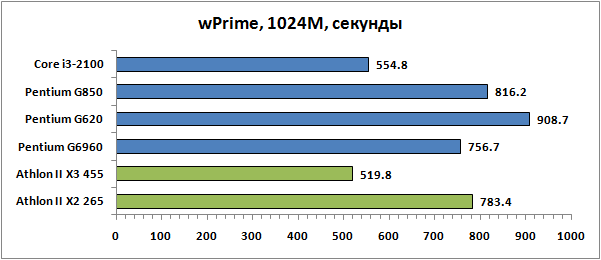
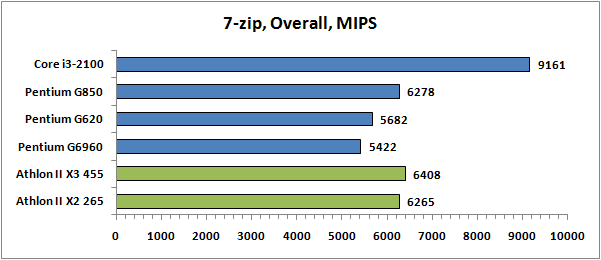
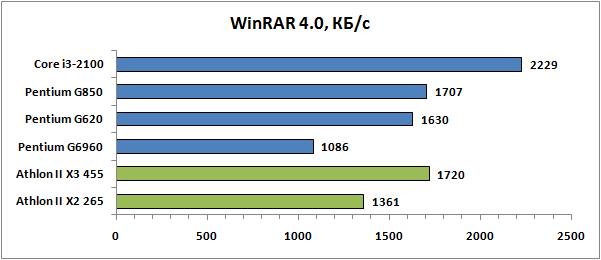
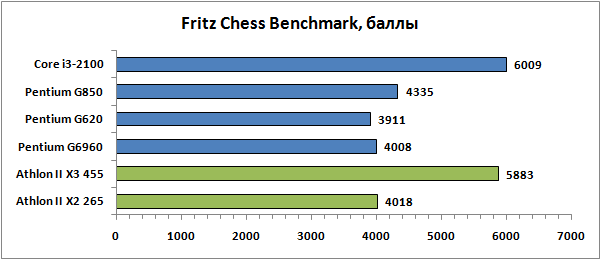
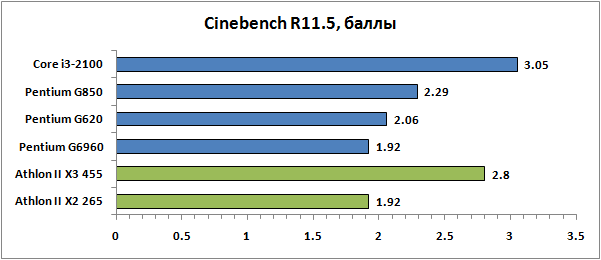
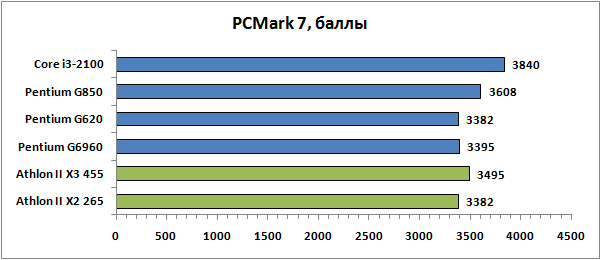
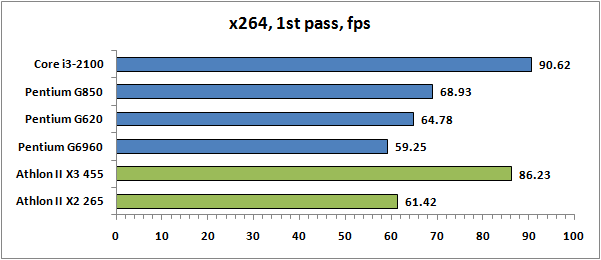
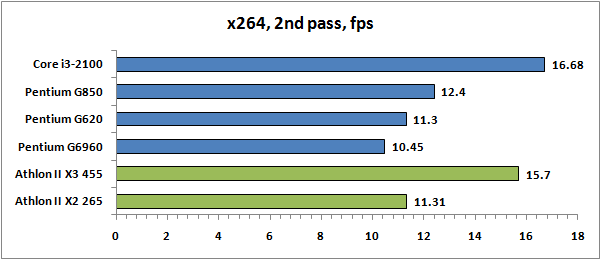
Summarizing the numbers shown in the graphs, we can formulate several conclusions. First, although the new Pentiums belong to the generation of Sandy Bridge processors, it is very difficult to call them close relatives of the Core i3. Between the results of these processors there is a whole abyss, which is the deeper, the better this or that application is optimized for multithreading. Still, the lack of support for Hyper-Threading is a very serious flaw, which, together with limited clock frequencies, results in an average gap between the Pentium G850 and the Core i3-2100 at the level of 30%.
Secondly, the new Pentiums really turned out to be significantly faster than the old ones - this is quite expected and natural.
But in the confrontation with AMD processors, there is no such unambiguity. The Pentium G620 is not always ahead of the Athlon II X2 265. One can even say that a certain parity has been established between these processors, with the exception of SuperPi, where representatives of the Pentium family performed with a phenomenally high result. Athlon II X3 455 turns out to be a powerful competitor even for the oldest of the new Pentiums. Its three cores guarantee a crushing advantage if the application is well optimized for multithreading. In the absence of explicit optimization, the Pentium G850 and Athlon II X3455 demonstrate approximately equal performance.
⇡ Test results in 3D games
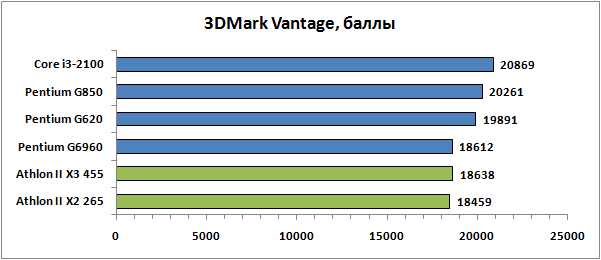
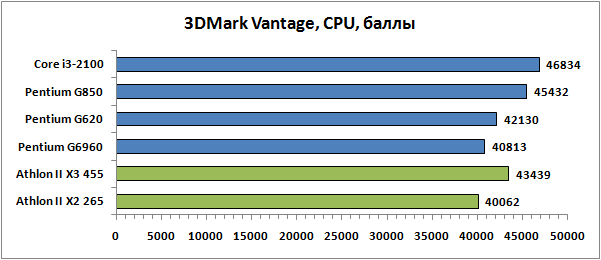
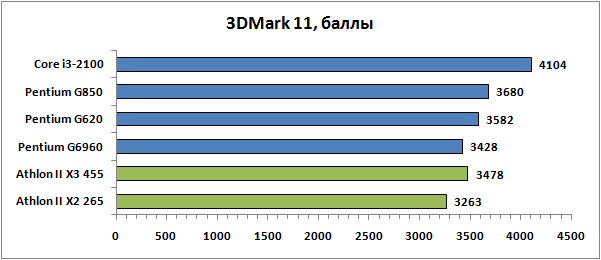
![]()
![]()
We would like to highlight the performance indicators obtained by us in the popular packages of the 3DMark series. After all, these are not real games, but some synthetic tests that simulate them. Moreover, they perform this with a clear bias in favor of Intel processors, since the results of Athlon II here clearly do not agree with what we saw earlier. Even the full-fledged three-core Athlon II X3 455 fails to get ahead of the new Pentiums here, which have only two cores and do not support Hyper-Threading.
However, in spite of what has been said, the new Pentiums are certainly faster than the old ones in games as well, so some progress is evident. Moreover, they definitely work better than the dual-core Athlon II.
In passing, I would like to note the following. We have long been accustomed to the fact that gaming performance depends primarily on the power of the graphics card. The processor affects the number of frames per second very weakly, especially when using high resolutions and high quality settings. However, in the case of weak CPUs, such as the Pentiums we are considering today, this promise turns out to be wrong. Even at the maximum settings, the dependence of performance on the processor is present, and sometimes it is even significant. So when forming an inexpensive gaming system, you need to pay close attention to balancing the capabilities of the CPU and GPU.
⇡ Overclocking
Overclocking is the weak point of any LGA1155 processors, except for the special overclocker models Core i7-2600K and Core i5-2500K. Due to the unification of the processor clock scheme and interface elements, overclockers have almost completely lost the ability to increase the BCLK frequency. Increasing the processor multiplier is allowed only on selected processors, and cheap Pentiums, of course, are not among them.
Therefore, all hopes that Pentium performance can be improved through overclocking should be abandoned. BCLK overfrequency limit on most motherboards is in the region of 104-107 MHz, which means that you should not count on an increase in the final CPU frequency by more than 5-7%.
For example, while experimenting with the Pentium G850 in our test system, we managed to increase the BCLK frequency to only 105.6 MHz without sacrificing stability, which resulted in an increase in the processor frequency from the stock 2.9 GHz to a modest 3.06 GHz.
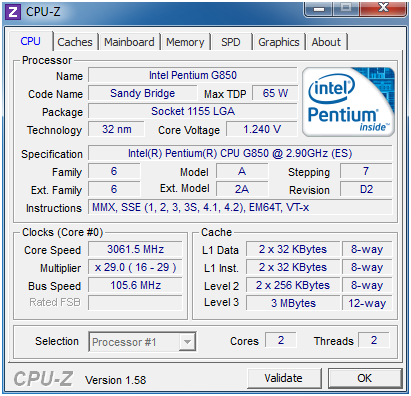
This means that if you are serious about overclocking experiments and think that the processor should operate at the limit of its capabilities, you should definitely not opt for Pentium for LGA1155. Any of inexpensive processors for alternative platforms that do not block overclocking, will allow you to get better performance after an abnormal increase in its clock frequency. In other words, the new Pentiums are contraindicated for overclockers.
⇡ Conclusions
The appearance of Pentium processors for the LGA1155 platform can only be welcomed. Their main advantage is the reduction in the minimum cost of the LGA1155 system, and this overshadows all their shortcomings. Given the promise of the LGA1155 platform, the new Pentium processors open up the possibility of creating low-cost computers that can then be easily improved up to the achievement of the most top level performance.
However, systems based on the Pentium G850/G840/G620 are not so bad even if you don't think about upgrading. These processors are significantly faster than their predecessors, sold under the same name, and competing dual core processors they are superior to AMD. Only their serious lag behind the full-fledged Core i3 is frustrating, but such is the fate of this family. Pentium features are cut too far compared to other Sandy Bridge to be put on a par with processors Core of the second generations.
The real alternative for the new Pentiums can only be the competitor's three-core processors, which show better performance under multi-threaded loads. In addition, the weak point of the novelty is the almost complete lack of overclocking. As for the rest, Pentium G850/G840/G620 are quite normal offers, the capabilities of which, in our opinion, fully correspond to their cost.
Despite the fact that they were released a long time ago by the standards of the computer industry (in 2011-2013), they continue to be topical solutions with a good level of performance. At the same time, in light of the release of more updated platforms, the cost of them has decreased significantly. This makes it even more justified to build a new PC based on this platform.
It should also be noted that this socket supports products based on the Core architecture of the second (they were also called "Sandy Bridge", and they were already produced using 32 nm technology) and even the third (the second name for this family of CPUs is "Evie Bridge", technology - 22 nm) generations. Most chips were equipped with an integrated graphics accelerator. Moreover, the more productive the processor, the better the graphics card.
Processor segmentation "Socket 1155"
The processors are divided into the following market segments:
Office PCs with minimal performance are Celeron.
More advanced computers entry level- Pentium.
The middle segment of system blocks is Core i3.
Intermediate chips between mid-range and premium are the Core i5.
The CPU that delivers the highest performance is the Core i7.
Pure office solutions
The most affordable semiconductor chip for Socket 1155 is the Celeron line of CPUs. Depending on the model, this silicon solution may include 1 or even 2 computing units. The frequency in this case is fixed, and in comparison with other products of this platform, it is minimal. Also, these CPU models have a reduced fast memory subsystem. On the one hand, all this allows to reduce the cost of the chip, and this is the most important criterion for this part of the market. On the other hand, all of the above significantly reduces the level of PC performance. But at the same time, it remains at an acceptable level for the solution. office tasks level.
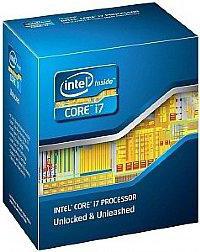
More advanced entry-level chips
One step higher in the list of Intel's proposals for this computing platform are Pentium CPUs, which already included 2 computing units without fail. Also, in comparison with Celeron, the clock frequency was increased (by 100-200 MHz) and the cache level. Therefore, you can find such 1155th socket even in entry-level gaming PCs, starting from these models it had an acceptable level of performance.
Middle segment
Socket 1155 processors for medium performance system block is Core i3. In terms of most technical parameters, they were identical to the younger models represented by the Pentium. This includes cache memory, the number of physical cores, and almost equal clock speeds. Their key feature was the presence of technology such as Hyper Trading. With its help, two physical modules at the software level turned into 4 processing threads software. As a result, in application programs optimized for 3-4 information processing threads, a speed increase was achieved, which could be 15 percent.
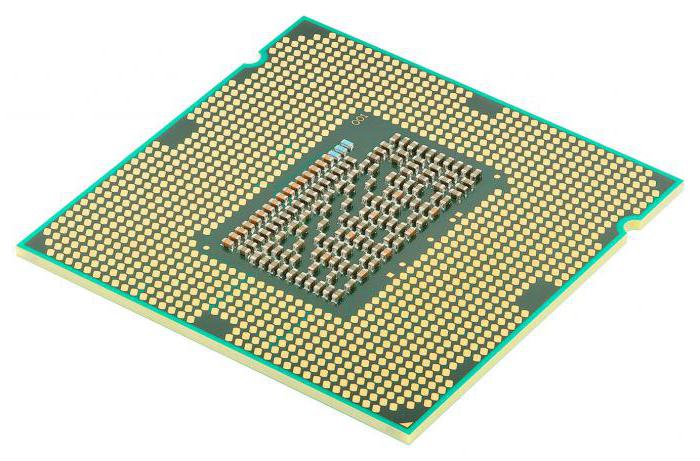
With an eye on premium
Core i5 was even higher in terms of performance in the list of CPUs for this platform. This is already a full-fledged quad-core processor. LGA 1155 with its help made it possible to create both affordable and productive computers. Also, this chip had an even larger cache, increased clock frequencies, and there is support for Intel's proprietary technology called "Turbo Boost". Accordingly, the CPU can change its frequencies depending on the level of complexity of the task. Separately, it is also necessary to note the chips of the series, in the marking of which there is an index "K" (it is added at the end of the designation of the processor model). In this case, the central factor processing device unlocked. As a result, with the proper configuration of the computer system, in this case, you can get a significant increase in performance. To do this, it will be enough just to overclock the chip.
Uncompromising performance
The most productive CPUs for Socket 1155 are Core i7. In terms of technical specifications, it is not so much different from the younger model. All the same 4 physical cores for performing calculations and a three-level cache. But it's all the same Hyper technology Trading, as in the case of Core i3, already made it possible to get 8 data streams and an additional performance boost. The second important factor is the increase in the third level cache from 6 MB to 8 MB, which also added speed computer system. As in the case of the Core i5, there were models with the “K” index, which can also be overclocked by increasing the clock frequency.
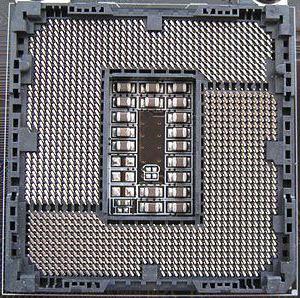
Summary
You can still purchase socket 1155 processors from stock. At the same time, their cost has been reduced against the backdrop of the release of more updated computing platforms in the face of LGA 1151 and, of course, LGA 1150. The performance difference between LGA 1155 and more recent products is not so significant. Therefore, from the point of view of the ratio "performance - cost" LGA 1155 looks more preferable. It is on it that you need to pay attention when assembling a new system unit with a limited budget and the desire to get the highest possible performance.
Finally, the long-awaited moment has come when you can get acquainted with the performance of Intel processors for the new LGA1155 platform! True, like last year, it fell exactly on holidays, but that's okay - after recovering from the rest, it's more interesting to go to the store :) By the way, not only the date makes today's event related to the announcement of processors based on the Clarkdale core a year ago. The fact is that the story with LGA1156 is essentially repeating itself - the announcement of new processors is stretched over several stages. Today we will learn all the details about the quad-core models of the Sandy Bridge architecture, but more affordable dual-core models will have to wait for almost a month and a half. "People's" Pentiums do not even fall into the first quarter.
But still, one and a half - not four, Pentium will appear much more than one, prices for them are expected to be more humane than for a single processor (well, one and a half) of this family under LGA1156, and Celeron are visible on the horizon: in a word, the company took into account the experience "Extended start" LGA1156 and similar errors, most likely, will not be made. Thus, starting from the second or third quarter of this year, LGA1155 will finally allow to abolish the healed LGA775 construct, and by the end of the year will also do away with LGA1156. But for some time these three platforms will exist in parallel, which, coupled with the surviving LGA1366 (and it will definitely live until the end of the year), will only increase the confusion on the market. However, these are the harsh realities of the modern market and we can hardly change them in any way. It remains only to carefully study everything and always make the right choice :)
There will be no theoretical part today. The fact is that we already had materials on this topic, and more detailed studies of microarchitecture are just around the corner. In general, we will not beat the bread from the theorists :) Also, for the time being, we will leave behind the scenes the issue of performance and functionality of the graphics core - this is also a separate and serious topic, which we will return to for a detailed study in the near future. At the moment, the main thing is to study the performance of the processor part itself and compare it with competing products from both Intel and AMD. To what we propose and go.
Test stand configuration
| CPU | Core i5-2300 | Core i5-2400 | Core i5-2500/2500K | Core i7-2600/2600K |
| Kernel name | Sandy Bridge | Sandy Bridge | Sandy Bridge | Sandy Bridge |
| Production technology | 32 nm | 32 nm | 32 nm | 32 nm |
| Core frequency (std/max), GHz | 2,8/3,1 | 3,1/3,4 | 3,3/3,7 | 3,4/3,8 |
| 28 | 31 | 33 | 34 | |
| How Turbo Boost works | 3-2-2-1 | 3-2-2-1 | 4-3-2-1 | 4-3-2-1 |
| 4/4 | 4/4 | 4/4 | 4/8 | |
| L1 cache, I/D, KB | 32/32 | 32/32 | 32/32 | 32/32 |
| L2 cache, KB | 4×256 | 4×256 | 4×256 | 4×256 |
| L3 cache, MiB | 6 | 6 | 6 | 8 |
| RAM | 2×DDR3-1333 | 2×DDR3-1333 | 2×DDR3-1333 | 2×DDR3-1333 |
| GMA HD graphics core | 2000 | 2000 | 2000/3000 | 2000/3000 |
| Graphics core frequency (max), MHz | 1100 | 1100 | 1100 | 1350 |
| socket | LGA1155 | LGA1155 | LGA1155 | LGA1155 |
| TDP | 95 W | 95 W | 95 W | 95 W |
| Price | $275 () | $236 () | $229 ()/N/A() | $340 ()/N/A() |
| Wholesale price at the time of announcement | $177 | $184 | $205/$216 | $294/$317 |
In the family of processors under LGA1156, two processors first appeared Core line i7 and only one Core i5, but now the ratio is reversed - one to three. The explanation is simple: the older Core i7-800s are still on the market and have adequate performance, so don't bother them too much. But the Core i5 is too motley company, which includes fast, but devoid of graphics processors of the 700th series and equipped with graphics, but rather weak (due to only two cores) Core i5-600. It is this imbalance that Intel decided to eliminate in the first place. Note that now Core i5 is Always four cores, and the "old" two-core/four-thread variant is present only in the cheaper Core i3 family. But these processors will be released a little later, since now the Core i3-500 is not so bad.
What does the comparison show? specifications? If earlier the Core i5-700 and Core i7-800 differed only in the presence / absence of Hyper-Threading support and frequencies, now the differences have become a little deeper: the i5 also has less cache memory. Moreover, the line is built in an interesting way - the step of the starting clock frequencies is uneven, but at the maximum frequency in the boost mode “everything is right”: a hundred in the index is equal to 300 MHz of the clock frequency. A very serious difference, since both Intel and AMD have already accustomed us to the fact that neighboring processors in the line differ only by one multiplier. It is still difficult to say whether the concept will continue in the future or whether the company will go to tighten the ranks, so we will postpone this issue for the future. In our opinion, "do not part" is very useful - there are already too many processors on the market, in which it is too easy to get confused. But there may be some progress - otherwise the Core i5-2300 looks a bit strange, whose price is only slightly lower than that of the 2400, but the clock frequency lag is greater than the difference between the older models. Unless in one-two-threaded applications, it is reduced, but there are fewer and fewer of them. Moreover, in favor of multithreading, the presence of background processes, which sometimes require not so few computing resources (and some of these background applications also became multi-threaded).
But with the Turbo Boost mode itself somehow ... More was expected. And the maximum increase has decreased to 400 MHz (do not forget that one "new" step is equal to 3/4 of the old one), and the dependence on the number of working cores has not gone away, although there were rumors that now it is possible to increase the frequency of all cores to the maximum. The only significant change is that now processors have the right to overclock "to the last": the boost mode is allowed to the TDP level (it used to be turned off at a lower limit), and if necessary, for a short time - even higher. Thus, a certain increase in performance under heavy load should be observed. Which one, let's check.
The main thing for fans of overclocking is that Turbo Boost in the new incarnation also supports such a feature as "Limited Unlocked Core" - the ability to set multipliers to "Max Turbo +4". That is, in other words, according to the Intel documentation, a completely ordinary Core i7-2500 will be able to operate at a frequency of 3.9 GHz when all cores are loaded, and when only one is loaded, it will even reach a frequency of 4.1 GHz! The reality turned out to be even more interesting - Gigabyte board, on which we tested the new family, of course, the multipliers were limited, but ... But for 2600, for example, the maximum value (namely 42) could be set for any number of active cores, i.e. with a slight movement of the hand, a processor with clocked at 3.4 GHz turns into a model with a frequency of 4.2 GHz. And we have strong suspicions that other boards based on the P67 chipset (with the possible exception of those made by Intel itself) will behave the same way.
Boards based on P67 also support “Fully Unlocked Core”, which allows using a multiplier up to 57 in any mode. However, this requires a K-series processor. Note that they are of interest not only to overclockers (and maybe not so much to them: as shown above, you can add 700-800 MHz on conventional processors): the K-series uses the HD 3000 series video core, but in conventional models - only only HD 2000, in which half of the execution modules are disabled. Thus, these processors will also be extremely useful for fans of integrated graphics, who will use them on boards based on the H67 chipset. But on the P67, it will not work to use the built-in video core (since there is no FDI link in it), but it will be possible to fully "retreat" during overclocking, as mentioned above. Moreover, when overclocking not only cores, but also memory: despite the fact that officially supported maximum mode is DDR3-1333, this is only true for H67. On the P67, higher multipliers are also available, which gives memory frequencies up to 2133 MHz. And the TDP level on these boards can be adjusted manually, increasing it during overclocking or, conversely, reducing it to save energy (which was previously available only for extreme processors). In general, when developing processors and chipsets for LGA1155, Intel took into account all past experience, putting things in order in their comparative positioning :)
| CPU | Core i5-680 | Core i5-760 | Core i7-880 | Core i7-975 Extreme | Core i7-980X Extreme |
| Kernel name | Clarkdale | Lynnfield | Lynnfield | Bloomfield | gulftown |
| Production technology | 32/45 nm | 45 nm | 45 nm | 45 nm | 32 nm |
| Core frequency (std/max), GHz | 3,6/3,87 | 2,8/3,33 | 3,06/3,73 | 3,33/3,6 | 3,33/3,6 |
| Starting multiplication factor | 27 | 21 | 23 | 25 | 25 |
| How Turbo Boost works | 2-1 | 4-4-1-1 | 5-4-2-2 | 2-1-1-1 | 2-1-1-1-1-1 |
| Number of cores/threads of calculation | 2/4 | 4/4 | 4/8 | 4/8 | 6/12 |
| L1 cache, I/D, KB | 32/32 | 32/32 | 32/32 | 32/32 | 32/32 |
| L2 cache, KB | 2×256 | 4×256 | 4×256 | 4×256 | 6×256 |
| L3 cache, MiB | 4 | 8 | 8 | 8 | 12 |
| UnCore frequency, GHz | 2,4 | 2,13 | 2,4 | 2,66 | 2,66 |
| RAM | 2×DDR3-1333 | 2×DDR3-1333 | 2×DDR3-1333 | 3×DDR3-1066 | 3×DDR3-1066 |
| 733 | — | — | — | — | |
| socket | LGA1156 | LGA1156 | LGA1156 | LGA1366 | LGA1366 |
| TDP | 73 W | 95 W | 95 W | 130 W | 130 W |
| Price | N/A() | N/A() | N/A() | N/A() | N/A() |
As it should be when testing a new family of processors, there will be more competitors than test subjects. Especially competitors produced in the same factories. The company of Intel processors we selected at first glance looks too colorful, but the selection logic is simple - the table (from left to right) shows:
Of course, we need the last two models mainly out of curiosity - any LGA1155 processor announced today is not ashamed to lose to them :) However, there are serious suspicions that the Core i7-2600 will not be able to lose to the "extreme" i7-975 Extreme (as no matter how hard he tries), but a comparison with the i7-980X on a wide range of applications is of considerable interest.
| CPU | Phenom II X4 970 | Phenom II X6 1090T |
| Kernel name | Deneb | Thuban |
| Production technology | 45 nm | 45 nm |
| Core frequency (std/max), GHz | 3,5 | 3,2/3,6 |
| Starting multiplication factor | 17,5 | 16 |
| Turbo CORE workflow | — | 3-3-3-0-0-0 |
| Number of cores/threads of calculation | 4/4 | 6/6 |
| L1 cache, I/D, KB | 64/64 | 64/64 |
| L2 cache, KB | 4×512 | 6×512 |
| L3 cache, MiB | 6 | 6 |
| UnCore frequency, GHz | 2,0 | 2,0 |
| RAM | 2×DDR3-1333 | 2×DDR3-1333 |
| Graphics core frequency, MHz | — | — |
| socket | AM3 | AM3 |
| TDP | 125 W | 125 W |
| Price | N/A(0) | N/A(0) |
Now let's move on to AMD. It is obvious that when the heavy equipment of the “blue” enters the battlefield, only guerrilla warfare and ambush actions remain “green”. In any case, this situation will last until the Superwaffe, codenamed "Bulldozer", rolls out of the laboratories, but there is quite a lot of time left until that moment. Today we will not touch the "Green partisans", in the form of hordes of various Athlon IIs, but we will consider a couple of "tank ambushes". The first one will be Phenom II X4 970 already familiar to our readers - a processor with the highest guaranteed clock speed among quad-core processors on the market (Core i7-2600 reaches 3.5 GHz only in boost mode, while others are not capable of this). As the second - Phenom II X6 1090T. The launch of this line last spring allowed the company to return to the $200-$300 market segment again, as the processors very successfully occupied a niche between the older Core i5 and younger Core i7 - let's see if they manage to maintain their positions taking into account the renewal of the product range Intel. In fairness, both the X4 and X6 families are expecting replenishment in the near future (more precisely, the 1100T appeared at the end of last year, and the 975 now), but since we are talking about only a slight increase in clock frequency, it is obvious that the qualitative picture is slightly more performance than used ones, Phenom II will not change Microsoft Excel spreadsheets.
3D visualization
The first group of programs - and the first discoveries. As we already know, these tasks do not require a large number of computational threads, so the speed with which these same threads (in the amount of two or three) are "run" through the processor comes first. That is, in other words, this is exactly the area where architecture optimizations can have the best effect. And they did - already the Core i5-2300 (the youngest and cheapest) overtook all the processors that we tested earlier. Including the extreme Core i7-975, which no one has been able to beat in this test so far. Other representatives new architecture, for obvious reasons, even faster, so there is simply no one to compete with them.
3D rendering
It seems to us that Sandy Bridge will have the last word in these tasks when the new set of AVX vector instructions appears in programs. So far, this is “pure” mathematics, and very well parallelized, so the more computation threads, the better: the force breaks straw. However, the high efficiency of each computation thread affects here as well. In particular, the new Core i5s are faster than the old ones with the same number of cores and at a comparable clock speed by 10 percent (looking at the diagram, do not forget that the i5-760 in boost mode operates at a frequency of 2.93 GHz, and the i5-2300 - only 2.9 GHz). But the transition to a thinner process technology allows the new processors to operate at higher frequencies, so that they can compete with the old Core i7 and the six-core Phenom II X6. And with the latter - even despite their higher frequency;) However, there are no miracles in the world, so the six-core Core i7 are out of reach, but they are much more expensive. Therefore, the second place of the Core i7-2600 is actually not a defeat, but a brilliant victory.
Scientific and engineering computing
Another basically low-flow group with small multi-thread interspersed, which distinguishes it from the first. But not much - the first two places were taken by processors under LGA1155 (the first was shared by as many as two, which once again shows that Hyper-Threading technology is still far from "free"), and the "penny" Core i5-2300 lost only to "multi-ruble" extreme processors of previous families.
Graphic editor
As we have already written more than once, the applications included in this group have very different preferences: Adobe Photoshop “loves” a lot of calculation threads, while the three “amateur” programs do not need them (and even interfere at times). Well, since there are three of them for one, it is not surprising that the dual-core (but high-frequency) Core i5-600 showed very good summary results earlier. Only extremals gave out more, where there are a lot of cores, and the frequencies are also rather big. "Family 2000" suits these programs even better, and in Photoshop its results are very good - here you have new leaders. In particular, the Core i7-2600 shocked, which in the Adobe software package almost caught up with the much more expensive six-core Core i7-970, and in the three remaining applications it simply has no competitors. The Core i5-2400 in them also showed a similar performance to the Core i5-680 (previously leading), but outperformed it in Photoshop by almost a factor of one and a half, which allowed this inexpensive model to take its place among the former leaders in terms of the totality of results. The Core i5-2500 is understandably faster than them and only behind the Core i7-2600. In general, only the youngest Core i5-2300 did not shake the imagination. Although if you remember that its wholesale price is only $ 177, and it “didn’t shock” against the background of processors for a whole hundred (or even all four - if you remember how much the Core i7-880 costs, to which the “baby” from the new line somewhat closer than to the equal-frequency Core i5-760) more expensive dollars, this is also just a wonderful result.
Archivers
7-Zip is able to use as many cores as it finds, all three subtests strongly "like" a large amount of cache memory, and the latter seems to be only interested in it - in general, it's not surprising that the new Core i5s did not perform so perfectly here , as in the previous groups: only four threads and a cache reduced to 6 MB make themselves felt. But "not perfect" does not mean bad - they easily bypassed all AMD processors and managed to reach about the level of the old Core i7, which cost about a hundred more. But in the new Core i7-2600 and support for hyper-threading there is, and an 8 MB cache, so its only competitor is the extreme Core i7-980X (even 975 is slower).
Compilation
Visual Studio turned out to be not the most loyal application to new processors - apparently, due to the fact that the compilation task was already among the best optimized ones. However, the Core i5-2300 slightly outperformed the Core i5-760: taking into account the smaller cache memory capacity (which is of considerable importance in this test) of the new product, this deserves a positive assessment. The increase (albeit small) is actually of strategic importance - as we remember, earlier in this program the Phenom II X6 were very good, located above the Core i5 and with older models reaching the younger Core i7. And now? And now with compilation quad-core(and "honest" - without any Hyper-Threading) Core i5-2400 copes with exactly the same speed as six-core Phenom II X6 1055T (albeit the youngest in the family, but more expensive)! And the next model with the 1075T index is not far behind, only one point ahead of the Core i5-2500. The older models, as we see, are still faster than even the new Core i5 and they can already be compared with the old Intel processor at the $294 bar, but the new one for the same money has galloped far ahead, and only lags behind six-core processors Intel itself. Moreover, it cannot be said that it is very noticeable - some 10% separates it from the current extreme Core i7-980X.
Java
But SPECjvm surprised me a little, because we are already used to citing this test as a good example of multi-core optimization. However, apparently, its capabilities extend to an area with eight to ten streams, but no more. While processors with different numbers of cores, but based on similar architectures, were competing, this gave an obvious priority to more multi-threaded models, but as soon as we started comparing models with different efficiency per thread ... In general, the Core i7-980X is still the fastest, but the superiority over the Core i7-2600 has become purely formal. Well, the Core i5-2400 somehow "didn't notice" that the Core i7-880 supports twice as many computation threads and has a close clock frequency, and almost caught up with him :)
Such an increase turned into a complete defeat of AMD processors - earlier Phenom II X4 970 was faster than all Core i5, and Phenom II X6 1090T overtook any Core i7-800. Now the Phenom II X4 970 slower all Core i5 for LGA1155, and Phenom II X6 1090T lags behind Core i5-2500. And it's no wonder that new Core i7 for LGA1155 six-core AMD already, in principle, can not compete in performance.
Internet browsers
Previously, this group of applications was the most loyal to the Phenom II X4, since even the model with the 965 index bypassed all Intel processors. Now, as we can see, even the Core i5-2300 can repeat the results of the previous tops, the Core i5-2400 overtakes the Phenom II X4 965 and only slightly falls short of 970, while the 2500 and 2600 are simply the fastest on the market. Without any reservations :) However, as we have said more than once, from a practical point of view, it makes no sense to attach great importance to the results of these tests on top processors, but from a research point of view, we mark with a tick that, perhaps, the last group has disappeared, where AMD processors held the lead.
Audio encoding
Another group of applications that can benefit greatly from the introduction of AVX over time, but so far operates only with “old” code. In addition, as has been said more than once, the testing conditions favor processors that are capable of simultaneously executing a large number of computation threads to the greatest extent. Therefore, at first glance, the new Core i5 is not so good here. But if you look closely, it becomes obvious that this is the level of the "old" Core i7 or Phenom II X6, i.e. more expensive CPUs. In any case, previously not a single quad-core crystal scored 150 points here, and now three are gaining more at once. The Core i7-2600, as expected, takes an honorable second place, trailing only the six-core (and twelve-core) Core i7-980X.
Video encoding
Similar to the previous picture. Only now the gap between 2600 and 980X has become larger, but it can be done - after all, devices of completely different price classes. The main thing is that new devices are able to defeat not only direct competitors, but also processors that are one step higher.
Games
Even in this group of applications, stagnation has ended. After which we started to run into a far from the slowest video card - for example, in Stalker and Resident Evil 5, all new processors showed the same results :) Which, it should be noted, turned out to be much higher than all the old ones. In general, the question of finding the best game processor, perhaps, should be considered solved in all cases when you can spend more than $ 150 on a purchase - such is the Core i5-2300. Or, if finances are not so pitiful, then the Core i5-2400, which costs quite a bit more, but “keeps” at the level of former extreme sportsmen. Top-end video cards or multi-GPUs remain “behind the scenes”, but here, as it seems to us, the question of the price of the processor is not decisive. Moreover, even the Core i7-2600 is not too expensive. And you can also overclock it by 400-800 MHz if you wish ... Or pay just a little extra for 2600K and overclock it even more. Or save a hundred and do the same procedure with the Core i5-2500K :) In general, the only choice will be for those who need a fast processor for games for $ 100 or who, on principle, want to take something very expensive.
Total
There was a time when the older Phenom II X4 models were sold for about $300, but the introduction of the Core i5-750 pushed all AMD processors into the sub-$200 price niche. The company was able to get out of it only by releasing the Phenom II X6. Now, it looks like history is repeating itself: already six-core Phenom IIs should be sold at prices not exceeding $200 - to the delight of some fans, but to the dismay of shareholders. (After all, it is obvious that quad-core processors manufactured according to the 32 nm process technology are cheaper in production than six-core ones at 45 nm, despite the presence of a video core in the first ones.) So it will be interesting to see how the "green" get out of this situation - before the release of Bulldozer- there is still quite a lot of time left.
Another family of processors was not so lucky. Yes, in fact, the Core i5-600 can be sent to the dustbin of history in full force. While it was necessary to make a choice: “four cores or integrated graphics?”, There was something to talk about. However, now the choice is obvious - four cores (faster than the old ones) And integrated graphics (faster than the old one) simultaneously. The new Core i5s are definitely better than the old ones. It looks a bit strange, perhaps, the current pricing policy: the 2400 differs from the 2300 by as much as 300 MHz and only $ 7, and from the 2500 by only 200 MHz and as much as $ 20, but this is quite explainable by the premium for steepness. Moreover, maybe after the release of the new i3 (which will finally write off all the processors on the Clarkdale core), the “ladder” will be redone into 155-177-204, which will be more logical.
If the new i5s are so good, what about the Core i7-2600? An excellent processor, the absolute triumph of which was spoiled only by the extreme Core i7-980X. But even then only in the overall standings - it's easy to see that in half of the test groups, even this expensive device can now compete only with the new Core i5, significantly pulling ahead only in a few cases. Yes, this is still a difficult share of six-core desktop environments: a very small percentage of software can make good use of their potential. In Intel, it seems to us, they very correctly decided that the time multi-core processors on the desktop it has already arrived, but "a lot" still means "four". For thrill-seekers, you can do more, but only if they are willing to pay for it :) And pay regularly - earlier, the same 980X competed only with the same extreme models, and now it doesn’t always win even with budget ones. And the previous extreme lost everywhere to the usual Core i7-2600. top, but usual. In general, the standard practice for Intel is that the new family of processors is unconditionally better than the old one, and the older models in it are no worse than the old extreme ones. Moreover, which is gratifying, even fans of overclocking and other optimizations now do not have to prepare another thousand dollars: there are not so expensive Core i5-2500K and i7-2600K. And even more versatile than their predecessors in the K-series, as they are interesting not only with fully unlocked multipliers, but also with a more powerful graphics core.
Summing up, should the release of new processors be considered successful? Yes, count. Even despite the changed design, which will once again force upgrade enthusiasts to change motherboards: the new processors are good enough to be tempted to do this procedure even by owners of systems with LGA1366 (if only because to change some i7-920 to i7-970 will be more expensive and less interesting than taking i7-2600K for new board) or LGA1156. Not to mention those who are still holding on to the LGA775 - it's time to finally retire any Core 2 Duo, and Core 2 Quad too. Well, those who buy complete computers receive just a small gift from the company - for the same money as in December last year, they can buy about 20 percent more processor power :)
